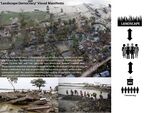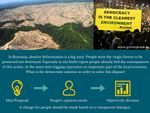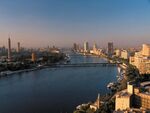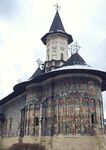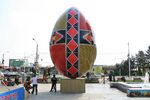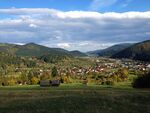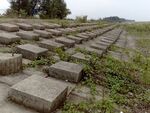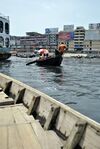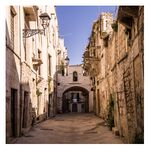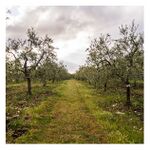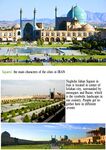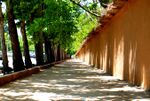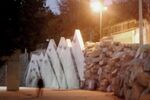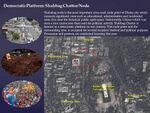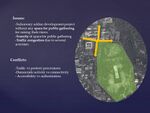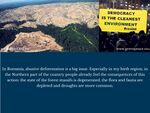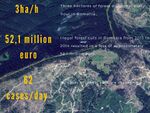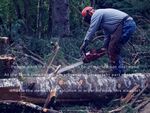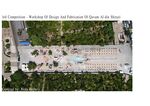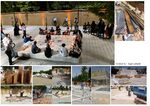LED Online Seminar 2017 - Working Group 7
--> Back to working group overview
Dear working group members. This is your group page and you will be completing the template gradually as we move through the seminar. Good luck and enjoy your collaboration!
Assignment 1 - Reading and Synthesizing Core Terminology
- You can read more details about this assignment here
- Readings are accessible via the resources page
Step 1: Your Landscape Democracy Manifestoes
Step 2: Define your readings
- Please add your readings selection for the terminology exercise before April 12:
A: Landscape and Democracy - Mapping the Terrain
Landscape Concepts:
- Mohammad Al Najdawi
- Kucan, Ana (2007). Constructing Landscape Conceptions. In: ECLAS (ed.). JoLA spring 2007, 30-41. Munich: Callwey.
- Burckhardt, Lucius (1979): Why is landscape beautiful? in: Fezer/Schmitz (Eds.) Rethinking Man-made Environments (2012) (Loredana Cîrdei)
B: Concepts of Participation
- Day, Christopher (2002): Consensus Design, Architectural Press (Loredana Cîrdei)
- Burckhardt, Lucius (1957): Urban Planning and Democracy in (Nastaran Jenabali)
C: Community and Identity
- Welk Von Mossner, Alexa (2014): Cinematic Landscapes(Nastaran jenabali)
D: Designing (Farzana Sharmin)
- Pritzker Prize winning architect Alejandro Aravena on sustainable design and community involvement in Chile
- Hester, Randolph: Democratic Drawing - Techniques for Participatory Design
E: Communicating a Vision
- Alessandro Mintrone
- Storytelling example from the Scottish Islands, Stromness: Urban Design Framework
Steps 3 and 4: Concepts Selection and definition
- Each group member selects three relevant concepts derived from his/her readings and synthesize them/publish them on the wiki by April 30, 2017
- Group members reflect within their groups and define their chosen concepts into a shared definition to be posted on the wiki by May 10, 2017.
- Other group members will be able to comment on the definitions until May 20, 2017
Concepts and definitions
Alessandro Mintrone:
- The Presence of the Past
- History, culture and and socio-economic superstructures are a non-material presence that comes from the past but defines the present.
- The Sense of Space
- The space, non only in his form, but also in its perception, it's the start, the mean and the end of every action on landscape
- The Perspective
- Landscape is not only something that "is", but also something in becoming like a living being. So we have to design time, not just space.
Farzana Sharmin:
- Coauthoring design: work as a joint force of people & designers and split the works.
- Use of common sense and nature to solve the problems.
- Representative representation
Loredana Cîrdei:
- Consensus-taking decisions: People involved in a debate will have a general agreement based on objective discussions rather than voting. Source: Christopher with Rosie Parnell Consensus Design-Socially inclusive process.
- Landscape is a creation: The visitors' minds construct the landscape through their background, education and expectations by applying different criterias. Source: Burckhardt, Lucius (1979): Why is landscape beautiful? in: Fezer/Schmitz (Eds.) Rethinking Man-made Environments (2012).
- Charming landscape: Identifying a graceful landscape is directly linked to rediscovering and remembering of past youth, impressions from the parental home, from the read books or from pictures on the walls of the childhood room. Source: Burckhardt, Lucius (1979): Why is landscape beautiful? in: Fezer/Schmitz (Eds.) Rethinking Man-made Environments (2012).
Mohammad Al Najdawi :
- Landscape features act as massage carriers. Kucan, Ana (2007)
- Landscapes can be the carriers of collective identity and historical memory. Kucan, Ana (2007)
- The social conception of space is formed in the systems of communication between society as a producer and the individual as a consumer. Kucan, Ana (2007)
Nastaranossadat Jenabalijahromi:
- The article portrays landscape as a chronological narrative where nature imitates social and environmental dynamics in regards to individuals and their accountability of the bittersweet consequences. a mare example of this presented in the article is the building of a levee witch was evidently for the purpose of economic and social hope, yet resulting in an overflow due to a hurricane eventually forcing the inhabitants to breach the levee, again for the same purpose of economic and social hope. Alexa (2014): Cinematic Landscapes
 Burckhardt, Lucius (1957): Urban Planning and Democracy
Burckhardt, Lucius (1957): Urban Planning and Democracy- The role of public,experts and politicians in decision making for urban development should be exactly specified. Burckhardt, Lucius (1957): Urban Planning and Democrac
Step 5: Reflection
- Please write, as a group, a 250 words reflection on your discourse and document it here
Step 6: Revised manifestoes
- please look again at your initial manifestoes and update them with any new aspects/prespectives you have taken up during this seminar
- Updatedmanifesto1.jpg
xy's updated manifesto
- Updatedmanifesto2.jpg
xy's updated manifesto
- Updatedmanifesto3.jpg
xy's updated manifesto
- Updatedmanifesto4.jpg
xy's updated manifesto
- Updatedmanifesto5.jpg
xy's updated manifesto
Assignment 2 - Your Landscape Symbols
- You can read more details about this assignment here
Landscape Symbols Author 1
- Symbol yourname photovoice4
add a caption (one paragraph max) description of the symbolism, interpretation, as well as geo-location
- Symbol yourname photovoice5
add a caption (one paragraph max) description of the symbolism, interpretation, as well as geo-location
Landscape Symbols Farzana sharmin
Landscape Symbols Alessandro Mintrone
Landscape Symbols Mohammad Al Najdawi
Landscape Symbols Nastaran Jenabali
- Symbol yourname photovoice4
add a caption (one paragraph max) description of the symbolism, interpretation, as well as geo-location
- Symbol yourname photovoice5
add a caption (one paragraph max) description of the symbolism, interpretation, as well as geo-location
Assignment 3 - Role Play on Landscape Democracy "movers and shakers"
- You can read more details about this assignment here
- Nastaran Jenabali > Robert Jungk (Zukunftswerkstatt)
- Mohammad Al Najdawi > : Julian Petrin et al., Hamburg (nexthamburg, German only)
- Loredana Cîrdei > : Randy Hester
Assignment 4 - Your Landscape Democracy Challenge
- You can read more details about this assignment here
- Each group member will specify a landscape democracy challenge in his/her environment
Landscape Democracy Challenge 1
- Democratic Platform
Your references:
Landscape Democracy Challenge 2
- Give a title to your challenge
Your references:
- ...
- ...
Landscape Democracy Challenge 3
- Give a title to your challenge
caption: what is the issue/conflict? There was 3rd competition workshop of design and fabrication of Qavam al-din shirazi ,April 21st- May 2nd 2017, in Shiraz afif abad garden, Ghavam al-din passage in shiraz. 120 architectures participated to construct urban element by using brick which was the most used material by Qavam,famous architect in Iran, through the landscape of city.It was held in front of Afif abad garden,through the historic district.They announced people to come and visit their pavilion on second of May, as constructing the pavilions took 3 days to be finished. Unfortunately all the pavilions were destroyed by municipality the day after of finishing the projects.
caption: what is the issue/conflict? Creating is display of the power of creativity and what is inside of you as an Architect. They allocated their time and energy with real and strong passion of designing to fabricate their own exhibition in their urban texture in order to shape a social landscape to attract people joining together with intention of more participation as a person who is living in a city.Municipality disappointed them by unconsidered their capability and penchant for creating .
- Yourname challenge 4.jpg
caption: who are the actors? Municipality, Architects , Citizens , Community members.
- ...
- ...
Landscape Democracy Challenge 4
- Nile banks utility
The challenge in my opinion is not just a problem could be defined but it is to find a good understanding of how this community is dealing with this element and to raise the question: is this element invested in the best way and about the future: If it continue to function the same way is there any negative impacts on environment, community, economy ….etc
Your references:
- ...
- ...
Landscape Democracy Challenge 5
- Give a title to your challenge
- Yourname challenge 1.jpg
caption: why did you select this case?
- Yourname challenge 2.jpg
caption: what is the issue/conflict (1)
- Yourname challenge 3.jpg
caption: what is the issue/conflict (2)
- Yourname challenge 4.jpg
caption: who are the actors?
Your references:
- ...
- ...
Assignment 5 - Your Democratic Change Process
- You can read more details about this assignment here
- After documenting and reflecting on your challenges you will continue jointly with one of these challenges and design a democratic change process
Your Democratic Change Process
- Add the title of your project
- Yourgroupname 2017 powermap.jpg
a power map identifying who is affected by the challenge and who is influencing it
- Yourgroupname 2017 change process (1).jpg
Look at the various methods and tools available and think how they can be applied creatively. Think about the needs of different stakeholder groups - you may need a methodical mix to address them all. Illustrate graphically how these methods/tools might be applied in a short, medium and long-term perspective.
- Yourgroupname 2017 scenario.jpg
a scenario illustrating how these tools can be applied within a short, medium and long term perspective involving the groups you want to address, this should include a process timeline
Reflection
- Evaluate in the group how far your ideas either built on the theoretical frame that has been introduced to you during this seminar or react to this by filling a potential gap (approx 150 words)
Your references
- ....
- ....
- ....
- ....

